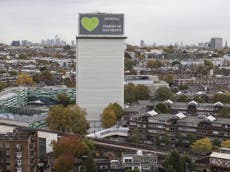Robert Jenrick is here to sort out the cladding problem – by doing the bare minimum, years too late
The cladding crisis is the latest thing to be levelled up. To level seven, in fact, and it’s your fault if you live below it


Never let it be said that Boris Johnson is not delivering on his promise to “level up” Britain. Within weeks of launching a tier system of coronavirus restrictions it had become such a success that all of the country was levelled up, as one, to the very highest level possible, where all of us remain. One people, one nation, one level.
And it is this radical levelling up agenda that has been brought to the flammable cladding crisis. This crisis has now been levelled up all the way to level seven. That, it turns out, is how many levels will need to be in your building – and absolutely no fewer – if you want any help from the government in sorting out a terrifying scandal it freely admits was not your fault, has quite possibly ruined (if not ended) your life, but doesn’t quite admit was theirs, either.
In perma s**tshow Britain, a new country which came into being around four and a half years ago, there are so many ongoing s**tshows at any one time, it is hard to be across the detail of all of them, so some background might be useful.
In 2016, Grenfell Tower in west London was redecorated with new cladding, which according to evidence given to the Grenfell Tower Inquiry this week, was known to be highly flammable by the company that manufactured it and sold it. (It was also known, by the company, to be far cheaper than the non-flammable alternative.)
A year later, it burned down and 72 people died. Four years later, the government remains committed to removing flammable cladding from buildings as soon as possible. Flammable cladding, it turns out, goes up very quickly indeed. Getting it down is a bit more of a painstaking job.
Since Grenfell, thousands of other flammable-clad buildings in the UK have been de facto declared unsafe, in a quite jaw-dropping failure of planning regulation, which has visited upon the people who own them and live in them both long years of night-time terror and complete financial ruin.
But the government is committed to sorting all that out now, four years later.
At the despatch box of the House of Commons, Robert Jenrick did his best to summon his grand statesman aura. Which is to say, he did his best to impress some of his own actual personage upon the occasion, but it isn’t easy. Even in a House of Commons which now rarely contains more than eight Tory MPs at any one time, one imagines Robert Jenrick’s own mother would struggle to pick out which one was Robert Jenrick.
Having been born in 1982, Robert Jenrick was 13 in the mid-1990s, as was Harry Enfield’s “Tory Boy” character. Since Mr Jenrick’s slow rise to very moderate fame, there have been no confirmed sightings of the two men in the same room at the same time.
We digress. Jenrick had £3.5bn to sort the problem out. Well, not quite sort out, as the real costs involved, according to MPs on the housing select committee, are in the region of £15bn. And if you live in a building that is less than 18 metres tall, none of that money is available to you. This, Mr Jenrick explained, is because such buildings are far less likely to burn down. So that’s nice.
He had some stats to back this up, one of which was that only 10 people died in high rise building fires in 2019, compared to more than 1,700 on the roads. Sadly, no other years were listed, perhaps for fear of copyright infringement on The Day Today’s Swimming Pool Attendant sketch.
Asked about the gaping holes in the policy, Jenrick found he could no longer hold back an especially joyous flourish. The prime minister, it transpires, is by no means the only who can be relied upon to lower any occasion with a quick turn of Latin.
What would happen to all those people for whom this rescue package provided almost nothing. English property law, Mr Jenrick explained, has always worked on the principle of “caveat emptor”. Buyer beware.
Technically, this catastrophic failure of government regulation, of staggering private sector greed, and dangerous concealment of information, was the fault of the little people, the ones who’d, you know, viewed a flat, had a survey done, bought a flat, and had imagined someone slightly above their pay grade, quite literally, had made sure it wasn’t liable to go up in flames at any moment to save the developers a few quid.
But, you know, things were different now. This government was stepping in, it was taking action. It was doing the right thing. The absolute bare minimum, and very long years too late.



Join our commenting forum
Join thought-provoking conversations, follow other Independent readers and see their replies
Comments